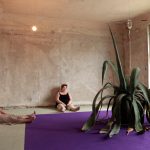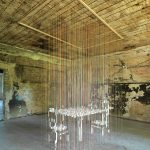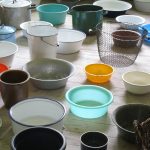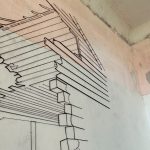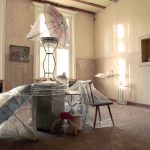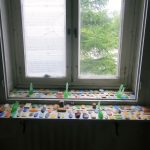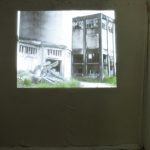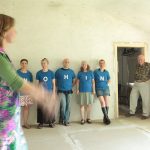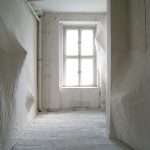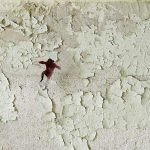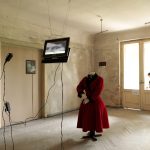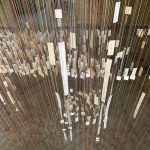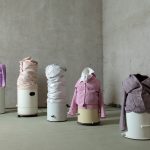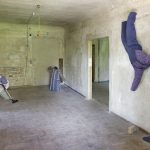english abstract → This year’s summer workshop with exhibition at the Villa Thyssen in Rüdersdorf near Berlin presents itself to the public with 19 artistic positions on four weekends. While Rüdersdorf, located to the east of Berlin, celebrates its 775th anniversary, the artists of the association Endmoräne are interested in its special history in the area of conflict between industrial culture, nature and the social world. The Rüdersdorf region is artistically a challenge in every respect – after all it stands for immense upheavals and contrasts. City–border–country collide here directly. Questions about becoming and passing away, existence or destruction are presented in an impressive way: Typically, the area characterized by industrial exploitation is called the „negative impression of Berlin“. Her limestone quarry digs into the terrain until today. Its historical traces – bizarre landscapes and imposing monuments as remnants of various epochs of production – are unique in Europe. With the demolition of huge industrial plants and the disappearance of countless jobs after 1989, the area is experiencing more than just a turnaround. Society, economy, ecology – nothing stays there as it was. The Endmoräne are dedicated to these changes: Under the motto „Gel (i) ebtes Leben“ (english: beloved/lived life), their current exhibition deals with DaSein, existence and ways of life of women in Brandenburg and especially in Rüdersdorf. Tine Neumann show less
Through the genres, painting, installations, performances, graphics and videos the artists of Endmoräne present their art and with it throw a whole new light on Rüdersdorf, its history and Villa Thyssen. A hitherto inaccessible industrial villa becomes an art space, a space for imagination, new stories, impulses and discourses.
Sommerwerkstatt und Ausstellung
Gel(i)ebtes Leben
Villa Thyssen, Rüdersdorf
Die diesjährige Sommerwerkstatt mit Ausstellung in der Villa Thyssen in Rüdersdorf bei Berlin präsentiert sich dem Publikum mit 19 künstlerischen Positionen an vier Wochenenden. Während das östlich von Berlin gelegene Rüdersdorf sein 775-jähriges Jubiläum feiert, interessieren sich die Künstlerinnen des Vereins Endmoräne für seine besondere Historie im Spannungsfeld von Industriekultur, Natur und Sozialwelt.
weiterlesen →
Diesen Veränderungen widmen die Endmoränen ihr Vorhaben: Unter dem Motto Gel(i)ebtes Leben befasst sich ihre aktuelle Ausstellung mit Da-Sein, Existenz und Lebensformen von Frauen in Brandenburg und speziell in Rüdersdorf. Quer durch die Genres präsentieren sich Malerei, Installationen, Performances, Grafik und Videos und werfen ein ganz neues Licht auf Rüdersdorf, seine Geschichte und die Villa Thyssen. Eine bis dahin nicht zugängliche Industriellenvilla wird zum Kunstraum, zum Freiraum für Phantasie, zu neuen Geschichten, Impulsen und Diskursen.
Tine Neumann
weniger anzeigen
Mit Arbeiten von | Kerstin Baudis, Ka Bomhardt, Claudia Busching, Monika Funke Stern, Gisela Genthner, Susu Grunenberg, Margita Haberland, Renate Hampke, Masko Iso, Gunhild Kreuzer, Ingrid Kerma, Dorothea Neumann, Elke Postler, Antje Scholz, Erika Stürmer-Alex, Christiane Wartenberg
Gastkünstlerinnen | Susanne Ahner (DE), Angela Lubič (DE), Katja Martin (DE)
Dauer der Ausstellung | 20. 06. – 11. 07. 2010
Gefördert von |
Ministerium für Wissenschaft, Forschung und Kultur des Landes Brandenburg
Ministerium für Arbeit, Soziales, Frauen und Familie des Landes Brandenburg
Landkreis Märkisch-Oderland
EWE Stiftung Oldenburg
Stienitzsee Real Estate GmbH, Hennickendorf
Architekturbüro Schmidtmann und Gölling, Berlin
Pfarrer Christian Langhammer, Hennickendorf

